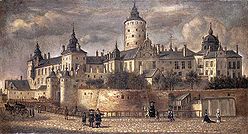
Lejonkulan
Encyclopedia

Theatre
Theatre is a collaborative form of fine art that uses live performers to present the experience of a real or imagined event before a live audience in a specific place. The performers may communicate this experience to the audience through combinations of gesture, speech, song, music or dance...
in Stockholm
Stockholm
Stockholm is the capital and the largest city of Sweden and constitutes the most populated urban area in Scandinavia. Stockholm is the most populous city in Sweden, with a population of 851,155 in the municipality , 1.37 million in the urban area , and around 2.1 million in the metropolitan area...
, Sweden
Sweden
Sweden , officially the Kingdom of Sweden , is a Nordic country on the Scandinavian Peninsula in Northern Europe. Sweden borders with Norway and Finland and is connected to Denmark by a bridge-tunnel across the Öresund....
, active 1667-89. It is mentioned in history as the first theatre in Sweden. In 1686, it was the place of the first Swedish Theatre.
History
Lejonkulan was a building down in and over the partly dry moat at the south corner of the royal palace Tre KronorTre kronor (castle)
Tre Kronor or Three Crowns was a castle located in Stockholm, Sweden, on the site where Stockholm Palace is today. It is believed to have been a citadel that Birger Jarl built into a royal castle in the middle of the 13th century...
. From 1648, it was commonly known by the name "Lejonkulan" ("The Lion's Den"), because two lion
Lion
The lion is one of the four big cats in the genus Panthera, and a member of the family Felidae. With some males exceeding 250 kg in weight, it is the second-largest living cat after the tiger...
s, a tribute from the Thirty Years War, was kept there during the reign of Queen Christina of Sweden, when the building at first was erected. Just like two other buildings nearer the palace, the Little and the Great Bollhuset
Bollhuset
Bollhuset, also called ', ', and ' at various times, was the name of the first theater in Stockholm, Sweden; it was the first Swedish theater and the first real theater building in the whole of Scandinavia. The name "" means "The Ball House", and it was built in 1627 for ball sports and used in...
, it was occasionally used for theatre.
In 1667, when the mourning period for the queen dowager-regent Hedwig Eleonora of Holstein-Gottorp
Hedwig Eleonora of Holstein-Gottorp
Hedwig Eleonora of Holstein-Gottorp was the queen consort of King Charles X of Sweden and queen mother of King Charles XI...
had ended and the Swedish court exploded with parties and a search for amusement, Lejonkulan was turned into a theater and decorated as such. Foreign theater companies were hired to perform for the court, often from France, Germany and the Netherlands, as Sweden did not have any theater tradition and therefore no native actors. Plays had been performed at the universities by students long before this, though, and in 1686, the first troupe of professional Swedish actors, made of students, (all male) opened the first Swedish language theatre in Lejonkulan Theatre.
Lejonkulan as a theatre has often been confused with Bollhuset
Bollhuset
Bollhuset, also called ', ', and ' at various times, was the name of the first theater in Stockholm, Sweden; it was the first Swedish theater and the first real theater building in the whole of Scandinavia. The name "" means "The Ball House", and it was built in 1627 for ball sports and used in...
Theatre, as the two buildings were both on and off used by the theatre during the same period. In 1689, the theatre was moved to Bollhuset, which had been used alongside Lejonkulan as an alternative theatrical space, and Bollhuset was renovated as a permanent local for the theatre in 1699. The reason for the change is unknown; some sources claim Lejonkulan burned down in 1689, while others assert that the change was made for artistic reasons. Lejonkulan burned down with the royal palace in 1697.
Actors and companies in the Theater of Lejonkulan
The following troupes likely also performed at the theatres of Little and Great BollhusetBollhuset
Bollhuset, also called ', ', and ' at various times, was the name of the first theater in Stockholm, Sweden; it was the first Swedish theater and the first real theater building in the whole of Scandinavia. The name "" means "The Ball House", and it was built in 1627 for ball sports and used in...
.
The Dutch troupe 1667-1674
This troupe opened the Theater with the play Orontes en Satira by Magnon in February 1667.- Salomon Fino
- Jan Baptista van Fornenberg, 1624-1697, director of the troupe.
- Helena Heusen, 1622-1680.
- Daniel Loodewicx
- Anna Parkar-Boonefaes
- Geertruyt Rijndorp-Boonefaes
- Dorotea van FornenberghDorotea van FornenberghDorotea van Fornenbergh , was a Dutch stage actor. Born to theatre director Jan Baptist van Fornenbergh and actor Helena Heusen , married in 1696 to Johan Hauman Gal...
The Dutch troupe 1680-1684
This troupe performed the play Disa for the public in 1684, and thus, the theater is known to be more than a court theater from this point forward.- Gillis Nozeman, husband of Ariana NozemanAriana NozemanAriana Nozeman : born Ariana van den Bergh , was the first actress in The Netherlands...
- Trial Parkar
- Jacob Sammers, 1632-1689.
The Swedish student-troupe from Uppsala 1686–1691
This (all male) troupe was made up of idealistic students. It had played in Uppsala 1682-86. They were moved to the locals in Bollhuset in 1689.- O. Rudbeck
- Isak Börk
- Carl Johan Ollieqvisth
- Andreas Strömbergh
- Georg Törnqvist-Adlercreutz

